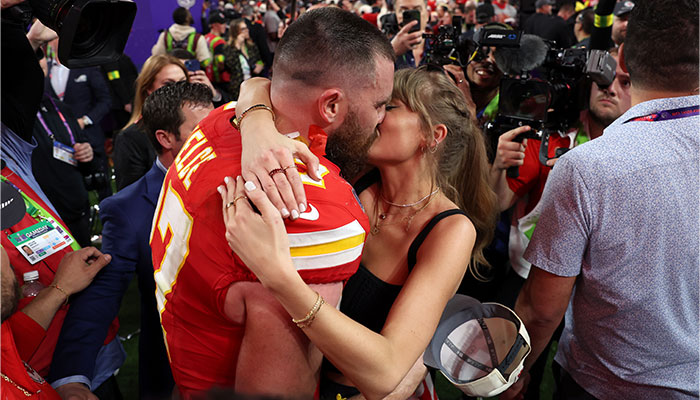By the time she departs Australia, following her final show on Monday night, more than half a million fans will have experienced Taylor Swift’s Eras Tour across her seven Melbourne and Sydney dates.

A league of her own: Taylor Swift has built her personal brand on meaningful engagement with fans.
The unprecedented demand for tickets is evidence of the bulletproof brand the 34-year-old global superstar has built. Swift is a marketing powerhouse, consistently reaching new heights, while catapulting affiliated brands into the spotlight as well.
The recent Super Bowl in Las Vegas is a case in point. Swift attended the game in support of her boyfriend, Travis Kelce, who plays for the Kansas City Chiefs. The Super Bowl is famously one of the world’s biggest sporting spectacles, yet it was Swift’s presence, not the game itself, that has been credited for a surge in Australian TV ratings. It was also the most-watched event in US TV history with more than 123 million viewers.
Swift is a masterful marketer. She plays the long game and has an incredible ability to create an engaging, mysterious and sophisticated fan-experience ecosystem, all the while taking advantage of some key psychological principles of behavioural economics.
Building a mystery
While many brands define engagement by social media reactions and comments, Swift consistently demonstrates how to go beyond basic fan engagement to deliver major experiences with far-reaching talkability.
Consider the Grammy Awards earlier this month. Swift made history, claiming the Best Album gong for a record fourth time, but she had already taken control of the narrative, making the surprise announcement that her 11th studio album was en route while accepting an earlier award.
To some devoted fans, this wasn’t such a surprise. Swift had dropped a few so-called ‘easter eggs’ – a term used to describe hidden messages strategically placed in (usually) electronic media – in the lead up to the announcement.
This strategy taps into a well-known psychological principle of behavioural economics known as the ‘curiosity gap’, which refers to the gap between what we know and what we desire to know.
The curiosity gap posits that individuals are more likely to register and recall incomplete or interrupted information than fully provided details. The act of filling these gaps serves as an incentive for people to stay engaged, potentially fostering prolonged interest.
These unravelling mysteries encourage continuous interpretation and speculation among her audience. Through this journey of exploration and discovery, fans are inclined to delve further, rewatching and relistening to her music to seek verification of their theories.
She plays the long game and has an incredible ability to create an engaging, mysterious and sophisticated fan-experience ecosystem.
This isn’t a new addition to Swift’s bag of tricks. Take her 2012 studio album Red, for example. Fans have pored over the liner notes to decode the messages hidden in uppercase letters among the otherwise lowercase text. One such message, hidden in the lyrics to ‘All Too Well’, is ‘maple latte’, which fans eventually traced back to a coffee date she shared with Hollywood star Jake Gyllenhall in 2010. There are said to be 16 hidden messages in these liner notes alone.
Making the most of merch
She is yet to take the stage, but the queue for Eras Tour merchandise in Sydney is already snaking around Accor Stadium. Swift’s approach to merchandise transcends merely selling products or capitalising on the success of her albums for increased revenue. Instead, it serves to extend the experience of her brand.
From themed merchandise that aligns with the thematic aspects of her albums to personalised items featuring her handwriting, Swift’s strategy enhances her connection with fans by offering them a tangible piece of her story.
For instance, Red merchandise included a replica of a ring she wore in one of the song’s music videos. Then there are the puzzle sets that offer new insights into her albums thanks to concealed messages, or easter eggs, incorporated in the designs.
Swift also applies the ‘scarcity’ principle by releasing exclusive and limited-edition merchandise, creating a sense of urgency and compelling fans to purchase quickly before they miss out.
Together, these strategies have fostered a sense of belonging and shared passion among her devotees, known as Swifties, who enjoy the resulting connectedness.
Kiss of visibility
Back to the Super Bowl, where Swift wore a black corset by Australian fashion designer Dion Lee. This was no accident. Swift’s Eras Tour kicked off in Australia just days after the NFL’s crowing game and this fashion choice was a signal to her curious fans that she had her sights set on the visit. Local cues like this also help boost Swift’s brand relevance on the ground.
Not surprisingly, the corset sold out in just a few days. It is currently available to pre-order.

Perfect fit: Swift wore Dion Lee at the Super Bowl, which gave the Australian designer priceless global exposure.
For Dion Lee, this is a brush with what I call the ‘kiss of visibility’. By association, the brand enjoyed a moment of glory, which will continue while the hype surrounding Swift’s Australian tour does.
Brands need not wait to be ‘kissed’ by the Swift marketing juggernaut. Plenty of businesses take it upon themselves to capitalise on the phenomenon through event-driven branding. Take the beloved Australian biscuit brand, Tim Tam, which this week released a Swift-inspired giveaway and a special-edition ‘Tay Tam’.
Such is her pull, even the US Democratic Party is rumoured to be looking at ways to hitch their wagon to Swift ahead of the 2024 presidential election. Perhaps she should run for President.
is a Senior Lecturer in the Department of Marketing, Macquarie Business School.








